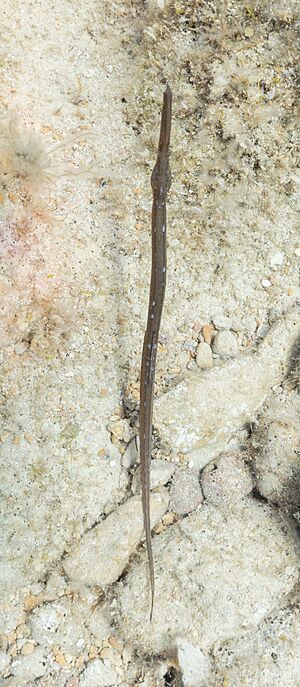Broadnosed pipefish facts for kids
Quick facts for kids Broadnosed pipefish |
|
|---|---|
 |
|
 |
|
| Conservation status | |
| Scientific classification | |
| Synonyms | |
|
The broadnosed pipefish (Syngnathus typhle) is a cool fish that belongs to the same family as seahorses! This family is called Syngnathidae. You can find these fish in the eastern Atlantic Ocean, from Norway all the way down to Morocco. They also live in the Baltic Sea, Mediterranean Sea, Black Sea, and Sea of Azov. They love shallow coastal waters, especially where there are seagrass beds. What makes them special is their wide snout, which is as deep as their body.
Contents
What Does a Broadnosed Pipefish Look Like?
The broadnosed pipefish is long and thin. Its body is shaped like a hexagon, which helps tell it apart from other pipefish. For example, the straightnose pipefish is rounder. The broadnosed pipefish has small, bony plates covering its body.
Its head looks a bit like a seahorse's, with a long, flat snout and a mouth that points upwards. Unlike some other pipefish, it has a fan-shaped tail fin. These fish are usually greenish, sometimes with darker spots. Their belly is often yellow. They typically grow to be about 15 to 20 centimeters (6 to 8 inches) long, but some can reach up to 25 centimeters (10 inches).
Where Do Broadnosed Pipefish Live?
These pipefish are found in the eastern Atlantic Ocean, the Mediterranean Sea, the Black Sea, and the Sea of Azov. Their home range stretches from Vardø in Norway down to Morocco. They usually live in waters up to about 20 meters (65 feet) deep.
How Do Broadnosed Pipefish Live and Eat?
Broadnosed pipefish often float upright among seaweed, blending in perfectly. They eat tiny sea creatures called plankton, like copepods. They suck these small animals into their mouths.
How Do Broadnosed Pipefish Have Babies?
Broadnosed pipefish have a unique way of raising their young. In this species, the females actually compete to find a male! This is different from many other animals where males compete for females.
Courtship Dance
When it's time to mate, both males and females try to attract each other. The courtship usually starts with one fish doing a special dance. If the other fish is interested, they will join in the dance. The female then uses a special tube called an ovipositor to put her eggs into the male's brood pouch. The male then fertilizes the eggs inside his pouch.
Male Pipefish Are Super Dads!
These pipefish have a special mating system where both males and females can have multiple partners during one breeding season.
What's really interesting is that the male pipefish are the ones who carry and protect the eggs. They have a special pouch on their body, like a kangaroo! Females can produce eggs faster than males can carry them. A male's pouch can't hold all the eggs from just one female, so he often carries eggs from several different females.
The male keeps the eggs in his pouch for about four to six weeks. During this time, he makes sure the eggs get enough oxygen and nutrients. When the baby pipefish hatch, the male releases them into the water. Even after they hatch, the male is still a super dad! The young pipefish can swim back into his pouch if they sense danger. This is a very high level of parental care!
Choosing a Mate
Even though males are the ones who carry the eggs, both male and female pipefish prefer to mate with larger partners. Why? Because bigger females lay more and larger eggs. And bigger males can carry more eggs and have healthier babies.
Males also try to avoid females who have a lot of parasites. This is because parasites can make the babies less healthy. Sometimes, pipefish can't always mate with their top choice. For example, if there are predators around, males might be less picky. But they have ways to make up for it! Females might put more nutrients into their eggs if they mate with a smaller male, to help the babies grow strong.


